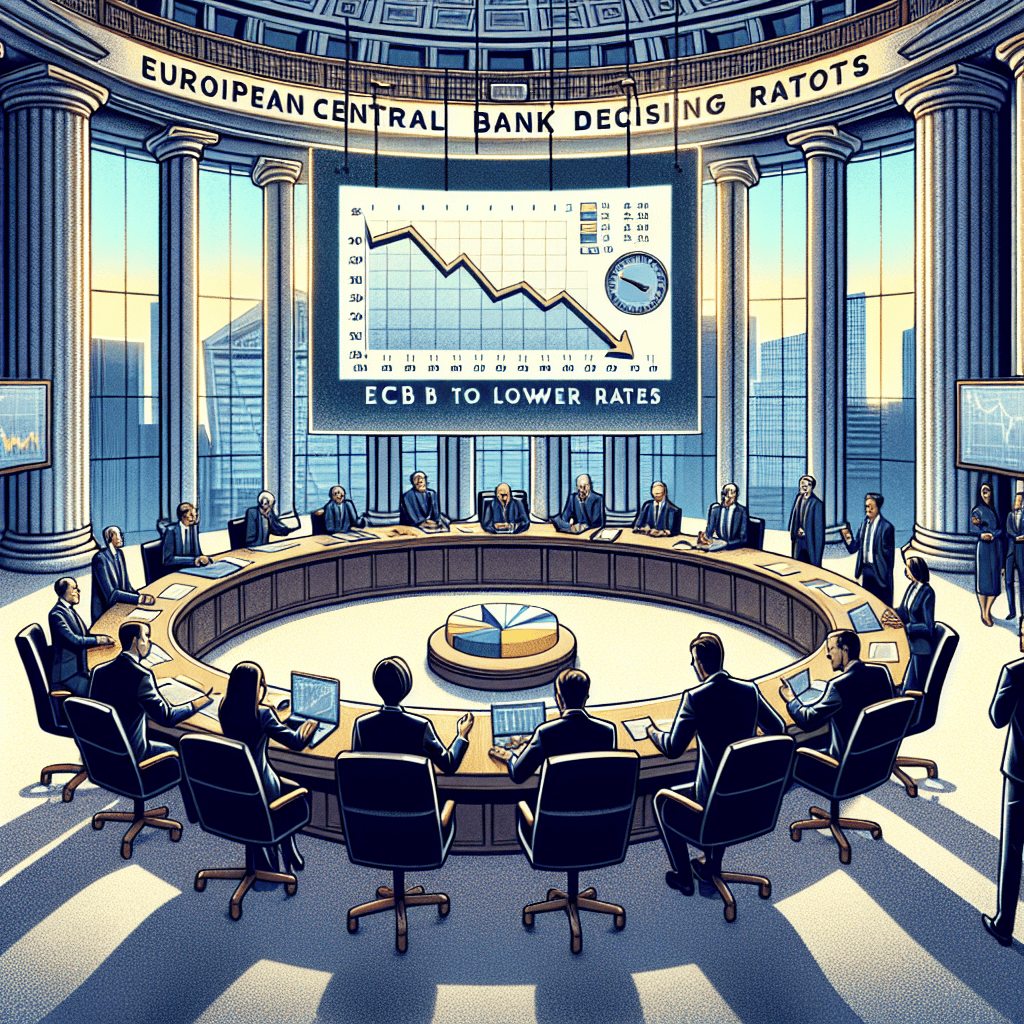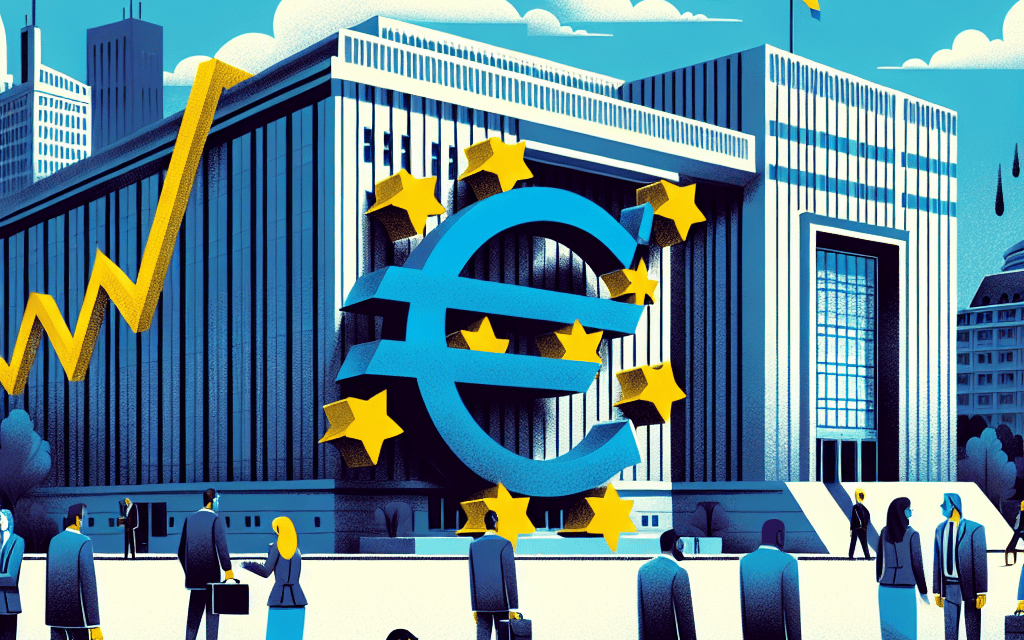“ECB Eases: Lower Rates to Boost Growth as Inflation Cools”
Introduction
The European Central Bank (ECB) is poised to adjust its monetary policy by lowering interest rates in response to a notable decline in inflation across the Eurozone. This strategic move aims to stimulate economic activity by making borrowing more affordable, thereby encouraging spending and investment. The decision comes as inflation rates have consistently fallen below the ECB’s target, raising concerns about potential deflationary pressures that could hinder economic growth. By reducing rates, the ECB seeks to bolster consumer confidence and support the region’s economic recovery, ensuring price stability and fostering a more robust economic environment.
Impact Of Lower Interest Rates On The Eurozone Economy
The European Central Bank’s (ECB) decision to lower interest rates comes at a pivotal moment for the Eurozone economy, as it grapples with the challenges of falling inflation. This move is anticipated to have a multifaceted impact on the economic landscape, influencing everything from consumer spending to business investment. As inflation rates continue to decline, the ECB’s strategy aims to stimulate economic activity by making borrowing more affordable, thereby encouraging both individuals and businesses to spend and invest.
Lowering interest rates typically reduces the cost of borrowing, which can lead to increased consumer spending. When consumers find it cheaper to finance large purchases, such as homes and cars, they are more likely to do so. This uptick in spending can drive demand for goods and services, providing a much-needed boost to the economy. Moreover, with lower interest rates, existing debt becomes less burdensome, freeing up additional disposable income for households. This increase in disposable income can further enhance consumer confidence, which is crucial for sustained economic growth.
In addition to stimulating consumer spending, reduced interest rates can also incentivize businesses to invest in expansion and innovation. When borrowing costs are low, companies are more likely to take out loans to finance new projects, purchase equipment, or hire additional staff. This can lead to increased productivity and competitiveness, which are essential for long-term economic health. Furthermore, as businesses expand, they create more job opportunities, which can help reduce unemployment rates across the Eurozone. Lower unemployment not only benefits individuals but also contributes to a more robust and resilient economy.
However, while the immediate effects of lower interest rates may seem beneficial, there are potential long-term implications that warrant consideration. For instance, prolonged periods of low interest rates can lead to asset bubbles, as investors seek higher returns in riskier markets. This can create instability in financial markets, posing a threat to economic stability. Additionally, savers may find that their returns on savings accounts and fixed-income investments diminish, which could discourage saving and impact future financial security.
Moreover, the ECB’s decision to lower rates must be carefully balanced with the need to maintain price stability. While the primary goal is to combat falling inflation, there is a risk that overly aggressive rate cuts could eventually lead to inflationary pressures if economic conditions change. Therefore, the ECB must remain vigilant and ready to adjust its monetary policy as needed to ensure that inflation remains within its target range.
In conclusion, the European Central Bank’s move to lower interest rates is a strategic response to the current economic environment characterized by falling inflation. By making borrowing more affordable, the ECB aims to stimulate consumer spending and business investment, which are critical drivers of economic growth. However, it is essential to consider the potential long-term effects of such a policy, including the risk of asset bubbles and the impact on savers. As the Eurozone navigates these complex economic dynamics, the ECB’s actions will play a crucial role in shaping the region’s economic future. Through careful monitoring and adjustment of its monetary policy, the ECB can help ensure that the benefits of lower interest rates are realized while mitigating potential risks.
How Falling Inflation Influences ECB’s Monetary Policy
The European Central Bank (ECB) is poised to lower interest rates as inflation across the Eurozone continues to decline, a move that underscores the intricate relationship between inflation trends and monetary policy. As inflation rates fall, central banks like the ECB are compelled to adjust their monetary strategies to ensure economic stability and growth. This dynamic is particularly crucial in the context of the Eurozone, where diverse economies are bound by a single monetary policy.
Inflation, the rate at which the general level of prices for goods and services rises, erodes purchasing power if left unchecked. Central banks typically aim for a moderate level of inflation, often around 2%, which is considered conducive to economic growth. However, when inflation falls significantly below this target, it can signal underlying economic weaknesses, such as reduced consumer demand or excess supply. In such scenarios, the ECB may opt to lower interest rates to stimulate economic activity by making borrowing cheaper, thereby encouraging spending and investment.
The decision to lower rates is not taken lightly, as it involves balancing various economic indicators and potential risks. Lowering interest rates can lead to increased borrowing and spending, which in turn can boost economic growth and help lift inflation back to target levels. However, it also carries the risk of encouraging excessive borrowing, potentially leading to asset bubbles or financial instability. Therefore, the ECB must carefully assess the current economic landscape, including factors such as employment rates, consumer confidence, and global economic conditions, before making such a decision.
Moreover, the ECB’s decision-making process is influenced by the unique structure of the Eurozone. Comprising 19 member countries, each with its own economic conditions and fiscal policies, the Eurozone presents a complex environment for monetary policy. While some member states may benefit from lower interest rates, others might face challenges such as overheating economies or rising debt levels. Consequently, the ECB must navigate these diverse conditions to implement a policy that supports the overall stability and growth of the Eurozone.
In recent months, inflation in the Eurozone has been on a downward trajectory, driven by factors such as declining energy prices and subdued wage growth. This trend has prompted the ECB to consider rate cuts as a means to counteract potential deflationary pressures. By lowering rates, the ECB aims to make borrowing more attractive, thereby encouraging businesses to invest and consumers to spend. This increased economic activity can help drive demand, ultimately supporting price stability and economic growth.
Furthermore, the global economic environment plays a significant role in shaping the ECB’s policy decisions. With major economies like the United States and China experiencing their own economic challenges, the Eurozone is not immune to external influences. Trade tensions, geopolitical uncertainties, and shifts in global demand can all impact the Eurozone’s economic outlook, necessitating a responsive and adaptive monetary policy.
In conclusion, the ECB’s anticipated move to lower interest rates amid falling inflation highlights the complex interplay between inflation trends and monetary policy. By carefully considering a range of economic indicators and potential risks, the ECB aims to foster an environment conducive to sustainable growth and stability across the Eurozone. As the global economic landscape continues to evolve, the ECB’s ability to adapt its monetary policy will remain crucial in navigating the challenges and opportunities that lie ahead.
The Role Of The European Central Bank In Stabilizing The Euro
The European Central Bank (ECB) plays a pivotal role in maintaining the stability of the euro, a currency that serves as the backbone of the Eurozone’s economy. As the primary institution responsible for monetary policy within the Eurozone, the ECB’s decisions significantly impact economic conditions across member states. Recently, the ECB has signaled a potential shift in its monetary policy by considering lowering interest rates, a move prompted by falling inflation rates across the region. This decision underscores the ECB’s commitment to its mandate of ensuring price stability, which is crucial for fostering economic growth and maintaining the purchasing power of the euro.
Inflation, a key indicator of economic health, has been on a downward trajectory in the Eurozone, raising concerns about potential deflationary pressures. Deflation, characterized by a general decline in prices, can lead to reduced consumer spending and investment, ultimately stalling economic growth. In response to these concerns, the ECB is contemplating a reduction in interest rates to stimulate economic activity. Lowering interest rates can encourage borrowing and spending by making credit more affordable, thereby injecting liquidity into the economy and counteracting deflationary trends.
The ECB’s potential rate cut is not an isolated decision but rather a strategic response to the broader economic landscape. The Eurozone has been grappling with various challenges, including geopolitical tensions, supply chain disruptions, and the lingering effects of the COVID-19 pandemic. These factors have contributed to economic uncertainty, necessitating a proactive approach from the ECB to safeguard the euro’s stability. By adjusting interest rates, the ECB aims to create a more conducive environment for economic recovery and resilience.
Moreover, the ECB’s decision to lower rates aligns with its dual objective of supporting economic growth while maintaining price stability. While inflation has been subdued, the ECB remains vigilant in monitoring economic indicators to ensure that its monetary policy is appropriately calibrated. The central bank’s actions are guided by a comprehensive assessment of economic conditions, including employment levels, consumer confidence, and global economic trends. This holistic approach enables the ECB to make informed decisions that balance short-term economic needs with long-term stability goals.
In addition to its monetary policy tools, the ECB collaborates with other European institutions to address structural challenges within the Eurozone. This collaborative effort is essential for fostering a resilient economic environment that can withstand external shocks. By working in tandem with national governments and other stakeholders, the ECB seeks to implement policies that promote sustainable growth and financial stability.
As the ECB prepares to potentially lower interest rates, it remains committed to transparent communication with the public and financial markets. Clear communication is vital for managing expectations and ensuring that the ECB’s policy intentions are well understood. By providing guidance on its monetary policy outlook, the ECB aims to build confidence among investors and consumers, thereby reinforcing the stability of the euro.
In conclusion, the European Central Bank’s consideration of lowering interest rates amid falling inflation highlights its proactive approach to stabilizing the euro. Through strategic monetary policy adjustments and collaboration with other European institutions, the ECB endeavors to create a stable economic environment that supports growth and resilience. As the Eurozone navigates a complex economic landscape, the ECB’s role in maintaining price stability and fostering economic recovery remains indispensable.
Pros And Cons Of Lowering Interest Rates In Europe

The European Central Bank (ECB) is poised to lower interest rates as inflation across the Eurozone shows signs of decline. This decision, while aimed at stimulating economic growth, carries with it a complex array of potential benefits and drawbacks. Understanding these pros and cons is crucial for policymakers, businesses, and consumers alike as they navigate the evolving economic landscape.
On the one hand, lowering interest rates can provide a much-needed boost to economic activity. By reducing the cost of borrowing, the ECB encourages businesses to invest in expansion and innovation. This, in turn, can lead to job creation and increased consumer spending, as individuals find themselves with more disposable income. Furthermore, lower interest rates can help alleviate the burden of debt for both households and companies, freeing up resources that can be redirected towards consumption and investment. In this way, the ECB’s decision could serve as a catalyst for economic recovery, particularly in regions that have been slow to rebound from recent downturns.
Moreover, a reduction in interest rates can also have a positive impact on the housing market. As borrowing becomes more affordable, demand for mortgages is likely to rise, potentially leading to an increase in property values. This can create a wealth effect, where homeowners feel more financially secure and are thus more inclined to spend, further stimulating the economy. Additionally, lower rates can make European exports more competitive on the global stage by weakening the euro, thereby boosting demand for goods and services produced within the Eurozone.
However, despite these potential advantages, there are also significant concerns associated with lowering interest rates. One major drawback is the risk of encouraging excessive borrowing, which can lead to the accumulation of unsustainable levels of debt. This is particularly concerning in an environment where economic growth remains uncertain, as it could result in financial instability if borrowers are unable to meet their obligations. Furthermore, persistently low interest rates can erode the profitability of banks, which rely on the spread between lending and deposit rates to generate income. This could lead to reduced lending capacity, ultimately counteracting the intended stimulative effects of the rate cut.
In addition, there is the issue of savers, who may find themselves disadvantaged by lower interest rates. As returns on savings accounts and fixed-income investments diminish, individuals may be forced to seek higher-risk alternatives in search of yield. This shift could expose them to greater financial risk, particularly if market conditions become volatile. Moreover, the prolonged period of low rates may also contribute to asset bubbles, as investors flock to equities and real estate in pursuit of better returns, potentially inflating prices beyond sustainable levels.
In conclusion, while the European Central Bank’s decision to lower interest rates amid falling inflation presents opportunities for economic revitalization, it is not without its challenges. The potential for increased investment, job creation, and enhanced export competitiveness must be weighed against the risks of excessive borrowing, financial instability, and adverse effects on savers. As Europe stands at this critical juncture, it is imperative for policymakers to carefully consider these factors and implement complementary measures that address the broader economic implications. By doing so, they can help ensure that the benefits of lower interest rates are maximized while mitigating the associated risks.
Historical Analysis Of ECB’s Rate Adjustments
The European Central Bank (ECB) has long played a pivotal role in shaping the economic landscape of the Eurozone through its monetary policy decisions. Historically, the ECB’s adjustments to interest rates have been closely tied to its primary mandate of maintaining price stability. As the Eurozone grapples with falling inflation, the ECB is once again poised to lower rates, a move that echoes its past strategies during periods of economic uncertainty.
To understand the current trajectory, it is essential to examine the historical context of the ECB’s rate adjustments. Since its inception in 1998, the ECB has navigated various economic challenges, employing interest rate changes as a key tool to influence economic activity. During the early 2000s, the ECB maintained relatively high interest rates to curb inflationary pressures. However, the global financial crisis of 2008 marked a significant shift in its approach. In response to the crisis, the ECB embarked on a series of rate cuts, reducing the main refinancing rate from 4.25% in 2008 to a historic low of 0.00% by 2016. This period underscored the ECB’s willingness to adopt an accommodative monetary policy to stimulate growth and prevent deflation.
As the Eurozone economy gradually recovered, the ECB began to cautiously raise rates in 2018, signaling a return to normalization. However, this upward trajectory was short-lived, as the onset of the COVID-19 pandemic in 2020 necessitated a swift reversal. The ECB promptly reinstated its accommodative stance, cutting rates and implementing a comprehensive package of measures to support the economy. This included the Pandemic Emergency Purchase Programme (PEPP), which aimed to stabilize financial markets and ensure favorable financing conditions.
In recent months, the Eurozone has witnessed a decline in inflation, prompting renewed discussions about the ECB’s monetary policy direction. Historically, falling inflation has often led the ECB to lower rates to stimulate demand and prevent a deflationary spiral. The current situation is no exception, as the ECB prepares to adjust its policy in response to evolving economic conditions. By lowering rates, the ECB aims to encourage borrowing and investment, thereby boosting economic activity and countering disinflationary pressures.
Moreover, the ECB’s decision-making process is influenced by a complex interplay of factors, including global economic trends, fiscal policies, and geopolitical developments. The ongoing war in Ukraine, for instance, has introduced additional uncertainties, impacting energy prices and supply chains. These external factors necessitate a careful calibration of monetary policy to ensure that the ECB’s actions align with its long-term objectives.
As the ECB contemplates its next move, it is crucial to consider the potential implications of rate adjustments on various sectors of the economy. Lower interest rates can provide relief to indebted households and businesses, reducing the cost of borrowing and supporting consumption and investment. However, they also pose challenges for savers and financial institutions, as prolonged periods of low rates can erode profitability and financial stability.
In conclusion, the ECB’s historical approach to rate adjustments offers valuable insights into its current policy considerations. As the Eurozone faces falling inflation, the ECB is set to lower rates, drawing on its past experiences to navigate the complexities of the present economic landscape. Through careful analysis and strategic decision-making, the ECB aims to fulfill its mandate of maintaining price stability while fostering sustainable economic growth.
Comparing ECB’s Strategy With Other Central Banks
The European Central Bank (ECB) is poised to lower interest rates as inflation across the Eurozone shows signs of decline. This strategic move comes at a time when central banks worldwide are grappling with the challenge of balancing economic growth with inflation control. The ECB’s decision to adjust its monetary policy reflects a broader trend among central banks, each adopting unique strategies tailored to their respective economic environments.
In recent months, the Eurozone has experienced a notable decrease in inflationary pressures, prompting the ECB to reconsider its monetary stance. By lowering interest rates, the ECB aims to stimulate economic activity, encouraging borrowing and investment while simultaneously supporting consumer spending. This approach is designed to foster a more robust economic recovery, particularly in the wake of the disruptions caused by the COVID-19 pandemic. The ECB’s strategy underscores its commitment to maintaining price stability and supporting the region’s economic growth.
Comparatively, the Federal Reserve in the United States has taken a different approach. While the ECB is moving towards rate cuts, the Federal Reserve has been more cautious, opting to maintain its current interest rates. This decision is influenced by the U.S. economy’s relatively strong performance and persistent inflationary pressures. The Federal Reserve’s strategy highlights its focus on preventing the economy from overheating while ensuring that inflation remains within its target range. This divergence in strategies between the ECB and the Federal Reserve illustrates the varying economic conditions and priorities that central banks must navigate.
Similarly, the Bank of England has adopted a distinct approach in response to its own economic challenges. With the United Kingdom facing unique post-Brexit economic dynamics, the Bank of England has been more inclined to adjust its monetary policy in response to domestic factors. While it has not yet signaled a move towards rate cuts, it remains vigilant in monitoring inflation trends and economic indicators. This cautious stance reflects the Bank of England’s emphasis on maintaining financial stability amid ongoing uncertainties.
In Asia, the Bank of Japan presents another contrasting strategy. The Japanese economy has long struggled with deflationary pressures, prompting the Bank of Japan to maintain an ultra-loose monetary policy. Despite global inflationary trends, Japan’s central bank has continued its commitment to low interest rates and quantitative easing measures. This approach aims to stimulate economic growth and achieve the Bank of Japan’s elusive inflation target. The persistence of deflationary challenges in Japan underscores the complexity of monetary policy in different economic contexts.
As central banks around the world navigate these diverse economic landscapes, the ECB’s decision to lower rates highlights the importance of flexibility and adaptability in monetary policy. Each central bank must carefully assess its domestic economic conditions, inflationary trends, and growth prospects to determine the most appropriate course of action. While the ECB’s strategy may differ from those of other central banks, it reflects a shared goal of fostering economic stability and growth.
In conclusion, the ECB’s move to lower interest rates amid falling inflation is a testament to the dynamic nature of central banking. By comparing the ECB’s strategy with those of other central banks, it becomes evident that there is no one-size-fits-all approach to monetary policy. Instead, central banks must tailor their strategies to their unique economic environments, balancing the dual objectives of promoting growth and maintaining price stability. As global economic conditions continue to evolve, the adaptability and responsiveness of central banks will remain crucial in shaping the future of the global economy.
Future Economic Projections For The Eurozone Post-Rate Cut
As the European Central Bank (ECB) prepares to lower interest rates, the Eurozone stands on the brink of a significant economic shift. This decision comes in response to a notable decline in inflation, which has been a persistent concern for policymakers aiming to stabilize the region’s economy. The anticipated rate cut is expected to have far-reaching implications, influencing various aspects of the Eurozone’s economic landscape.
To begin with, the reduction in interest rates is likely to stimulate economic growth by making borrowing more affordable for businesses and consumers alike. Lower borrowing costs can encourage companies to invest in expansion and innovation, potentially leading to increased productivity and job creation. For consumers, reduced interest rates may translate into lower mortgage and loan payments, thereby increasing disposable income and boosting consumer spending. This, in turn, could invigorate retail sectors and contribute to a more robust economic environment.
Moreover, the ECB’s decision to lower rates is anticipated to have a positive impact on the Eurozone’s export market. A decrease in interest rates often leads to a depreciation of the euro, making European goods and services more competitively priced on the global stage. This could enhance the region’s trade balance and support industries that rely heavily on exports. As a result, countries within the Eurozone that are heavily dependent on trade may experience a resurgence in economic activity, further bolstering the overall economic outlook.
However, while the potential benefits of a rate cut are significant, there are also challenges that must be considered. One such challenge is the risk of asset bubbles, particularly in real estate markets. With lower interest rates, there is a possibility that property prices could inflate rapidly, leading to unsustainable growth and potential market corrections in the future. Policymakers will need to remain vigilant and implement measures to mitigate these risks, ensuring that the benefits of lower rates do not come at the expense of long-term stability.
In addition, the ECB’s move to lower rates may have implications for savers and financial institutions. With reduced returns on savings accounts, individuals may seek alternative investment opportunities, potentially increasing their exposure to riskier assets. Banks, on the other hand, may face pressure on their profit margins due to the narrowing gap between lending and deposit rates. This could lead to a reevaluation of business models and strategies within the banking sector, as institutions strive to maintain profitability in a low-interest-rate environment.
Furthermore, the broader geopolitical landscape could also influence the effectiveness of the ECB’s rate cut. Factors such as trade tensions, political uncertainties, and global economic trends may impact the Eurozone’s recovery trajectory. It is crucial for policymakers to remain adaptable and responsive to these external influences, ensuring that monetary policy adjustments are complemented by fiscal measures and structural reforms.
In conclusion, the European Central Bank’s decision to lower interest rates amid falling inflation presents both opportunities and challenges for the Eurozone. While the move is poised to stimulate growth, enhance competitiveness, and support economic recovery, it also necessitates careful consideration of potential risks and external factors. As the region navigates this complex economic landscape, a balanced approach that combines monetary policy with strategic fiscal initiatives will be essential to achieving sustainable growth and stability in the post-rate-cut era.
Q&A
1. **Question:** What is the primary reason for the European Central Bank considering lowering interest rates?
– **Answer:** The primary reason is falling inflation within the Eurozone.
2. **Question:** How does lowering interest rates typically affect inflation?
– **Answer:** Lowering interest rates generally stimulates economic activity by making borrowing cheaper, which can help increase inflation towards target levels.
3. **Question:** What impact does a rate cut by the European Central Bank have on the Euro currency?
– **Answer:** A rate cut can lead to a depreciation of the Euro as lower interest rates make the currency less attractive to investors seeking higher returns.
4. **Question:** How might lower interest rates affect consumer spending in the Eurozone?
– **Answer:** Lower interest rates can boost consumer spending by reducing the cost of loans and mortgages, leaving consumers with more disposable income.
5. **Question:** What are potential risks associated with the European Central Bank lowering interest rates?
– **Answer:** Potential risks include asset bubbles due to cheap borrowing, reduced savings returns, and limited effectiveness if rates are already low.
6. **Question:** How could a rate cut influence the European Central Bank’s monetary policy credibility?
– **Answer:** If the rate cut successfully stabilizes inflation, it could enhance the ECB’s credibility. However, if it fails to achieve desired outcomes, it might undermine confidence in the ECB’s policy effectiveness.
7. **Question:** What other measures might the European Central Bank consider alongside lowering rates to address falling inflation?
– **Answer:** The ECB might consider quantitative easing, forward guidance, or targeted long-term refinancing operations to complement rate cuts and stimulate the economy.
Conclusion
The European Central Bank (ECB) is poised to lower interest rates in response to declining inflation across the Eurozone. This decision reflects the ECB’s commitment to maintaining price stability and supporting economic growth. As inflation rates fall below the ECB’s target, reducing interest rates can stimulate borrowing and spending, thereby boosting economic activity. However, this move also highlights the challenges faced by the ECB in balancing growth and inflation, especially in a complex global economic environment. The rate cut is expected to provide short-term relief to the economy, but it also underscores the need for structural reforms and fiscal policies to ensure long-term stability and growth.





